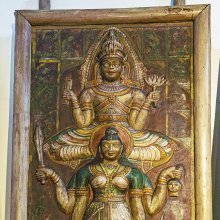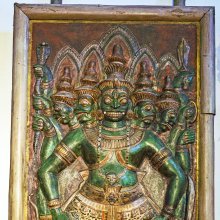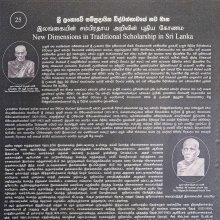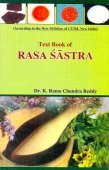Dirgha, Dīrgha, Dīrghā: 34 definitions
Introduction:
Dirgha means something in Buddhism, Pali, Hinduism, Sanskrit, the history of ancient India, Marathi, Hindi, biology. If you want to know the exact meaning, history, etymology or English translation of this term then check out the descriptions on this page. Add your comment or reference to a book if you want to contribute to this summary article.
Alternative spellings of this word include Dirgh.
Images (photo gallery)
In Hinduism
Shaktism (Shakta philosophy)
Source: Wisdom Library: Śrīmad Devī BhāgavatamDīrgha (दीर्घ):—One of the persons joining Śiva during the preparations of the war between Śankhacūḍa and the Devas, according to the Devī-bhāgavata-purāṇa (9.20.22-53). All persons attending were remained seated on beautiful aerial cars, built of jewels and gems. The war was initiated by Puṣpadanta (messenger of Śiva) who was ordered to restore the rights of the Devas. .
Source: Google Books: ManthanabhairavatantramDīrghā (दीर्घा) refers to one of the eight Yoginīs (yoginī-aṣṭaka) associated with Candrapīṭha (or Candrapīṭhapura), according to the Manthānabhairavatantra, a vast sprawling work that belongs to a corpus of Tantric texts concerned with the worship of the goddess Kubjikā.—[...] The eight Yoginīs (yoginyaṣṭaka): Oṃkārā, Dīrghā, Dhūmrākṣī, Dhūmrā, Kalahapriyā, Vyālākṣī, Kākadṛṣtī, Tripurāntakī

Shakta (शाक्त, śākta) or Shaktism (śāktism) represents a tradition of Hinduism where the Goddess (Devi) is revered and worshipped. Shakta literature includes a range of scriptures, including various Agamas and Tantras, although its roots may be traced back to the Vedas.
Purana and Itihasa (epic history)
Source: archive.org: Puranic EncyclopediaDīrgha (दीर्घ).—A king of Magadha. He was killed by Pāṇḍu. (Mahābhārata Ādi Parva, Chapter 112, Verse 27).
Source: Cologne Digital Sanskrit Dictionaries: The Purana IndexDīrghā (दीर्घा).—A Kalā of Viṣṇu.*
- * Brahmāṇḍa-purāṇa IV. 35. 95.

The Purana (पुराण, purāṇas) refers to Sanskrit literature preserving ancient India’s vast cultural history, including historical legends, religious ceremonies, various arts and sciences. The eighteen mahapuranas total over 400,000 shlokas (metrical couplets) and date to at least several centuries BCE.
Vyakarana (Sanskrit grammar)
Source: archive.org: Uṇādi-Sūtras In The Sanskrit Grammatical TraditionDīrgha (दीर्घ).—One of the technical terms which have been used in the uṇādi-sūtras;—Dīrgha, “A term used in connection with the lengthened tone of a vowel described to be ‘dvimātra’ as contrasted with ‘hrasva’ having one ‘mātrā.” The terms, hrasva and dīrgha occur in as many as twenty-four sūtras.
Source: Wikisource: A dictionary of Sanskrit grammarDīrgha (दीर्घ).—Long: a term used in connection with the lengthened tone of a vowel described to be dvimatra as contrasted with ह्रस्व (hrasva) having one matra and प्लुत (pluta) having three matras; cf. द्विस्तावान् दीर्घः (dvistāvān dīrghaḥ) V. Pr. I. 35, V. Pr. I. 57, also ऊकालोज्झ्रस्वदीर्घप्लुतः (ūkālojjhrasvadīrghaplutaḥ) P, I.2.27.

Vyakarana (व्याकरण, vyākaraṇa) refers to Sanskrit grammar and represents one of the six additional sciences (vedanga) to be studied along with the Vedas. Vyakarana concerns itself with the rules of Sanskrit grammar and linguistic analysis in order to establish the correct context of words and sentences.
Pancaratra (worship of Nārāyaṇa)
Source: Wisdom Library: PāñcarātraDīrgha (दीर्घ) refers to an aspect of nṛsiṃha (‘man-lion’), according to the Vihagendra-saṃhitā 4.17, which mentions seventy-four forms (inlcuding twenty forms of vyūha). He is also known as Dīrghanṛsiṃha or Dīrghanarasiṃha. Nṛsiṃha is a Tantric deity and refers to the furious (ugra) incarnation of Viṣṇu.
The 15th-century Vihagendra-saṃhīta is a canonical text of the Pāñcarātra corpus and, in twenty-four chapters, deals primarely with meditation on mantras and sacrificial oblations.
Source: University of Vienna: Sudarśana's Worship at the Royal Court According to the AhirbudhnyasaṃhitāDīrgha (दीर्घ) or Dīrghāyus refers to a “long (life)”, according to the Ahirbudhnyasaṃhitā, belonging to the Pāñcarātra tradition which deals with theology, rituals, iconography, narrative mythology and others.—Accordingly, “Such a Court Officiant who is [himself] like a Guru to Kings is difficult to find. Such a one is verily capable of warding off the flood of misdeeds [and their consequences] for Kings. Therefore, he alone is able to perform the rituals of protection of Kings. He who has such a Guru [by his side] shall become a sovereign King, one with a long life (dīrgha-āyus), one free of enemies and diseases and a slayer of hostile heroes”.

Pancaratra (पाञ्चरात्र, pāñcarātra) represents a tradition of Hinduism where Narayana is revered and worshipped. Closeley related to Vaishnavism, the Pancaratra literature includes various Agamas and tantras incorporating many Vaishnava philosophies.
Shilpashastra (iconography)
Source: archive.org: Illustrations of Indian Music and Dance in Western Indian StyleDirgha (दिर्घ) refers to one of the forty-seven tānas (tone) used in Indian music.—The illustration of Dirgha (as a deity) according to 15th-century Indian art is as follows.—The colour of his body is yellow. His face is similar to the face of a Krauñca. A flower is in his right hand and a viṇā in his left hand.
The illustrations (of, for example Dirgha) are found scattered throughout ancient Jain manuscripts from Gujarat. The descriptions of these illustrations of this citrāvalī are based on the ślokas of Vācanācārya Gaṇi Sudhākalaśa’s Saṅgītopaniṣatsāroddhāra (14th century) and Śārṅgadeva’s Saṅgītaratnākara (13th century).

Shilpashastra (शिल्पशास्त्र, śilpaśāstra) represents the ancient Indian science (shastra) of creative arts (shilpa) such as sculpture, iconography and painting. Closely related to Vastushastra (architecture), they often share the same literature.
Natyashastra (theatrics and dramaturgy)
Source: Shodhganga: Mankhaka a sanskrit literary genius (natya)Dīrgha (दीर्घ, “long”).—A verse in Sanskrit is of four feet or quarters or pādas. Each pāda is regulated either by a number of syllables (akṣaras) or by a number of syllabic instant or measures (mātrās). A syllable is short or long i.e. hrasva or dīrgha according to its vowel is short or long. But short vowel becomes long in prosody, when it is followed by anusvāra, visarga or by a conjunct consonant. The last syllable of a pāda is optionally long or short according to the exigence of the metre, whatever be its natural length.

Natyashastra (नाट्यशास्त्र, nāṭyaśāstra) refers to both the ancient Indian tradition (shastra) of performing arts, (natya—theatrics, drama, dance, music), as well as the name of a Sanskrit work dealing with these subjects. It also teaches the rules for composing Dramatic plays (nataka), construction and performance of Theater, and Poetic works (kavya).
Chandas (prosody, study of Sanskrit metres)
Source: Shodhganga: a concise history of Sanskrit Chanda literatureDīrgha (दीर्घ, “long”) or Guru or Ga refers to long letter in a verse.—The whole chanda literature has several technical terms, by which it is controlled. Single letters are used to denote a specific instance. The letter ga stands for guru letter while the letter la stands for laghu letter. In a verse the letter which is guru is also known as dīrgha (long) and which is laghu is also known as hrasva (short). The dīrgha letter consists of two mātrās while the hrasva letter consists of one mātrā.
Guru symbols can be identified as the shape of tāṭaṅka, hāra or keyūra, and the laghu can be identified as menu, kāhāla (daṇḍa) or śara.

Chandas (छन्दस्) refers to Sanskrit prosody and represents one of the six Vedangas (auxiliary disciplines belonging to the study of the Vedas). The science of prosody (chandas-shastra) focusses on the study of the poetic meters such as the commonly known twenty-six metres mentioned by Pingalas.
Ayurveda (science of life)
Nighantu (Synonyms and Characteristics of Drugs and technical terms)
Source: WorldCat: Rāj nighaṇṭuDīrghā (दीर्घा) is another name for Pṛśniparṇī, a medicinal plant identified with Uraria picta Desv. from the Fabaceae or “legume” family of flowering plants, according to verse 4.37-39 of the 13th-century Raj Nighantu or Rājanighaṇṭu. The fourth chapter (śatāhvādi-varga) of this book enumerates eighty varieties of small plants (pṛthu-kṣupa). Together with the names Dīrghā and Pṛśniparṇī, there are a total of twenty-four Sanskrit synonyms identified for this plant.

Āyurveda (आयुर्वेद, ayurveda) is a branch of Indian science dealing with medicine, herbalism, taxology, anatomy, surgery, alchemy and related topics. Traditional practice of Āyurveda in ancient India dates back to at least the first millenium BC. Literature is commonly written in Sanskrit using various poetic metres.
Jyotisha (astronomy and astrology)
Source: Wisdom Library: Brihat Samhita by VarahamihiraDīrgha (दीर्घ) refers to the long” types of Ketus (i.e., luminous bodies such as comets and meteors), according to the Bṛhatsaṃhitā (chapter 11), an encyclopedic Sanskrit work written by Varāhamihira mainly focusing on the science of ancient Indian astronomy astronomy (Jyotiṣa).—Accordingly, “The comets which are white, of single disc, without tails and glossy are named Vikacā Ketus and are the sons of Jupiter. They are 65 in number; they appear in the south and when they appear mankind will not be happy. The comets that are neither very bright nor clearly visible to the naked eye, and that are long [i.e., dīrgha] and white are named Taskara Ketus; they are the sons of Mercury, they appear anywhere and are 51 in number; when they appear mankind will feel miserable”.

Jyotisha (ज्योतिष, jyotiṣa or jyotish) refers to ‘astronomy’ or “Vedic astrology” and represents the fifth of the six Vedangas (additional sciences to be studied along with the Vedas). Jyotisha concerns itself with the study and prediction of the movements of celestial bodies, in order to calculate the auspicious time for rituals and ceremonies.
Vastushastra (architecture)
Source: Brill: Śaivism and the Tantric Traditions (architecture)Dīrgha (दीर्घ) refers to a “long (hall)”, according to the Mohacūrottara (verse 4.234-243).—Accordingly, [while describing the construction of the maṭha]—“[...] The installation of the houses is according to the wishes [of the patron]. There should be a [door for] entry and exit to the north. [The houses] may have one, two, or three floors, or as is pleasing. Externally, [the building] is surrounded by a long hall (dīrgha-śālā). In the eastern side of the building is the place for worship. One should install the kitchen and so forth as appropriate. [...]”.

Vastushastra (वास्तुशास्त्र, vāstuśāstra) refers to the ancient Indian science (shastra) of architecture (vastu), dealing with topics such architecture, sculpture, town-building, fort building and various other constructions. Vastu also deals with the philosophy of the architectural relation with the cosmic universe.
In Buddhism
Mahayana (major branch of Buddhism)
Source: Wisdom Library: Maha Prajnaparamita Sastra1) Dīrgha (दीर्घ) refers to “length” (Cf. Dīrghatva, “longness”), according to Mahāprajñāpāramitāśāstra (chapter 2).—Accordingly, “[Question: The past and the future do not function with the nature of the present; the past functions with the nature of the past and the future with the nature of the future. That is why there is a [different] time for each nature separately (ekaika dharmalakṣaṇa)]—[Answer:]—[...] [The Buddhist texts] do not speak about kāla but about samaya in order to dispel wrong views of this kind. We speak metaphorically about time with regard to birth, the elements and bases of consciousness, but there is no distinct time [existing as a separate substance]. Expressions such as ‘region’ (deśa), ‘time’ (kāla), ‘separation’ (viyoga), ‘union’ (saṃyoga), ‘singleness’ (ekatva), ‘multiplicity’ (nānātva), ‘length’ (dīrghatva), ‘smallness’ (hrasvatva), etc., come from convention. Fools (bāla) cling to them and say that these are real Dharmas (sadbhūta). That is why mundane conventional Dharmas of purely nominal existence must be excluded.”.
2) Dīrgha (दीर्घ) is mentioned as the general of the Yakṣas, according to the 2nd century Mahāprajñāpāramitāśāstra chapter 36.—Accordingly, “one day the Buddha, apeaking to Tch’ang (Dīrgha), the general of the Yakṣas (yakṣasnānī), praised the three good disciples A-ni-lou-t’o (Aniruddha), Nan-t’i-kia (Nandika) and Tch’e-mi-lo (Kimbila). The Buddha said to Dīrgha: ‘If the entire world with its gods and men thinks about these three sons of noble family with faith, it will obtain immense benefits during the long night (dīrgharātra)’”.

Mahayana (महायान, mahāyāna) is a major branch of Buddhism focusing on the path of a Bodhisattva (spiritual aspirants/ enlightened beings). Extant literature is vast and primarely composed in the Sanskrit language. There are many sūtras of which some of the earliest are the various Prajñāpāramitā sūtras.
General definition (in Buddhism)
Source: Wisdom Library: Dharma-samgrahaDīrgha (दीर्घ, “long”) refers to one of the “twenty form objects” (rūpa) as defined in the Dharma-saṃgraha (section 34). The Dharma-samgraha (Dharmasangraha) is an extensive glossary of Buddhist technical terms in Sanskrit (e.g., dīrgha). The work is attributed to Nagarjuna who lived around the 2nd century A.D.
India history and geography
Source: Cologne Digital Sanskrit Dictionaries: Indian Epigraphical GlossaryDīrghā.—(CII 1), distance or the distant future. Note: dīrghā is defined in the “Indian epigraphical glossary” as it can be found on ancient inscriptions commonly written in Sanskrit, Prakrit or Dravidian languages.

The history of India traces the identification of countries, villages, towns and other regions of India, as well as mythology, zoology, royal dynasties, rulers, tribes, local festivities and traditions and regional languages. Ancient India enjoyed religious freedom and encourages the path of Dharma, a concept common to Buddhism, Hinduism, and Jainism.
Biology (plants and animals)
Source: Wisdom Library: Local Names of Plants and DrugsDirgha [दीर्घ] in the Sanskrit language is the name of a plant identified with Baliospermum solanifolium (Burm.) Suresh from the Euphorbiaceae (Castor) family having the following synonyms: Baliospermum axillare, Baliospermum montanum, Jatropha montana. For the possible medicinal usage of dirgha, you can check this page for potential sources and references, although be aware that any some or none of the side-effects may not be mentioned here, wether they be harmful or beneficial to health.
Source: Google Books: CRC World Dictionary (Regional names)1) Dirgha in India is the name of a plant defined with Aglaia odorata in various botanical sources. This page contains potential references in Ayurveda, modern medicine, and other folk traditions or local practices It has the synonym Aglaia odorata var. microphyllina C. DC..
2) Dirgha is also identified with Argyreia nervosa It has the synonym Ipomoea speciosa (L.f.) Pers. (etc.).
3) Dirgha is also identified with Caryota urens It has the synonym Caryota urens Blanco (etc.).
Example references for further research on medicinal uses or toxicity (see latin names for full list):
· Flora Indica (1824)
· Taxon (1979)
· Bulletin de l’Herbier Boissier (1897)
· Botanische Jahrbücher für Systematik, Pflanzengeschichte und Pflanzengeographie (1893)
· Monographiae Phanerogamarum (1878)
· Hortus Britannicus (1826)
If you are looking for specific details regarding Dirgha, for example diet and recipes, pregnancy safety, side effects, extract dosage, health benefits, chemical composition, have a look at these references.

This sections includes definitions from the five kingdoms of living things: Animals, Plants, Fungi, Protists and Monera. It will include both the official binomial nomenclature (scientific names usually in Latin) as well as regional spellings and variants.
Languages of India and abroad
Marathi-English dictionary
Source: DDSA: The Molesworth Marathi and English Dictionarydīrgha (दीर्घ).—a (S) Long;--whether in space or time. 2 Long--a vowel. 3 Deep, grave, weighty--a deliberation &c.
Source: DDSA: The Aryabhusan school dictionary, Marathi-Englishdīrgha (दीर्घ).—a Long; deep.
Marathi is an Indo-European language having over 70 million native speakers people in (predominantly) Maharashtra India. Marathi, like many other Indo-Aryan languages, evolved from early forms of Prakrit, which itself is a subset of Sanskrit, one of the most ancient languages of the world.
Sanskrit dictionary
Source: DDSA: The practical Sanskrit-English dictionaryDīrgha (दीर्घ).—a. (Compar. drāghīyas, Superl. drāghiṣṭha)
1) Long (in time or space), reaching far; दीर्घाक्षं शरदिन्दुकान्ति वदनम् (dīrghākṣaṃ śaradindukānti vadanam) M.2.3; दीर्घान् कटाक्षान् (dīrghān kaṭākṣān) Meghadūta 37; दीर्घापाङ्ग (dīrghāpāṅga) &c.
2) Of long duration, lasting long, tedious; दीर्घयामा त्रियामा (dīrghayāmā triyāmā) Meghadūta 11; V.3.4; Ś.4.15.
3) Deep (as a sigh); Amaruśataka 13; दीर्घमुष्णं च निश्वस्य (dīrghamuṣṇaṃ ca niśvasya).
4) Long (as a vowel), as the आ (ā) in काम (kāma).
5) Lofty, high, tall.
6) Dilated, expanded; तृष्णादीर्घस्य चक्षुषः (tṛṣṇādīrghasya cakṣuṣaḥ) Uttararāmacarita 3.46.
-rghaḥ 1 A camel.
2) A long vowel.
3) The fifth, sixth, seventh, and eighth signs of the zodiac.
4) A kind of grass or reed.
-rghā A long lake or oblong tank.
-rgham ind.
1) Long, for a long time.
2) Deeply.
3) Far.
Source: Cologne Digital Sanskrit Dictionaries: Edgerton Buddhist Hybrid Sanskrit DictionaryDīrgha (दीर्घ).—(= Pali Dīgha), name of a yakṣa: Mahā-Māyūrī 235.11; 237.2.
Source: Cologne Digital Sanskrit Dictionaries: Shabda-Sagara Sanskrit-English DictionaryDīrgha (दीर्घ).—mfn.
(-rghaḥ-rghā-rghaṃ) Long, applied either to space or time. m.
(-rghaḥ) 1. The Sal tree. 2. A long vowel. 3. The 5th, 6th, 7th or 8th sign of the zodiac. E. dṝ to divide or send, affix ghañ .
Source: Cologne Digital Sanskrit Dictionaries: Benfey Sanskrit-English DictionaryDīrgha (दीर्घ).—i. e. dṛh (for original dargh), + a, I. adj., f. ghā Long, applied either to space or time, Rām, 5, 17, 28; 3, 68, 36; ºgham, adv. 2, 62, 3; comparat. dīrghatara, [Pañcatantra] 209, 1; and drāghīyaṃs; superl. dīrghatama, [Bhāgavata-Purāṇa, (ed. Burnouf.)] 7, 5, 44, and drāghiṣṭha. Ii. m. A long vessel, Man, 2, 33.
Source: Cologne Digital Sanskrit Dictionaries: Cappeller Sanskrit-English DictionaryDīrgha (दीर्घ).—[adjective] long ([space and time]); [neuter] [adverb]; [abstract] tā† [feminine], tva† [neuter]
Source: Cologne Digital Sanskrit Dictionaries: Monier-Williams Sanskrit-English Dictionary1) Dīrgha (दीर्घ):—mf(ā)n. ([Comparative degree] drāghīyas, [superlative degree] drāghiṣṭha [qq. vv.]; rarely dīrghatara [Pañcatantra] iv, 13/14 and tama [Bhāgavata-purāṇa vii, 5, 44]) long (in space and time), lofty, high, tall
2) deep, [Ṛg-veda; Atharva-veda; Brāhmaṇa] etc.
3) long (in prosody), [Prātiśākhya; Manu-smṛti] etc.
4) m. a long vowel, [Gobhila-śrāddha-kalpa ii, 8, 15; Kātyāyana-śrauta-sūtra] etc.
5) a camel, [cf. Lexicographers, esp. such as amarasiṃha, halāyudha, hemacandra, etc.]
6) Saccharum Sara
7) Shorea Robusta = utkaṭa, rāma-śara etc., [cf. Lexicographers, esp. such as amarasiṃha, halāyudha, hemacandra, etc.]
8) a mystical Name of the letter a, [Upaniṣad]
9) the 5th or 6th or 7th or 8th sign of the zodiac, [Jyotiṣa]
10) Name of a prince of Magadha, [Mahābhārata i, 4451]
11) of Śiva, [Mahābhārata xiii, 1158]
12) Dīrghā (दीर्घा):—[from dīrgha] f. an oblong tank (cf. ghikā), [Rāmāyaṇa v, 16, 27]
13) [v.s. ...] a kind of plant= -pattrā, [cf. Lexicographers, esp. such as amarasiṃha, halāyudha, hemacandra, etc.]
14) [v.s. ...] a mystical Name of the letter n, [Upaniṣad]
15) Dīrgha (दीर्घ):—n. a species of grass, [cf. Lexicographers, esp. such as amarasiṃha, halāyudha, hemacandra, etc.]
16) Name of a Sāman, [Ārṣeya-brāhmaṇa]
17) [Fr. √drāgh; cf. also [Greek] δυλιχός; Sl. dlŭgŭ.]
Source: Cologne Digital Sanskrit Dictionaries: Yates Sanskrit-English DictionaryDīrgha (दीर्घ):—[(rghaḥ-rghī-rghaṃ) a.] Long. m. Sāl tree.
Source: DDSA: Paia-sadda-mahannavo; a comprehensive Prakrit Hindi dictionary (S)Dīrgha (दीर्घ) in the Sanskrit language is related to the Prakrit word: Dīha.
[Sanskrit to German]
Sanskrit, also spelled संस्कृतम् (saṃskṛtam), is an ancient language of India commonly seen as the grandmother of the Indo-European language family (even English!). Closely allied with Prakrit and Pali, Sanskrit is more exhaustive in both grammar and terms and has the most extensive collection of literature in the world, greatly surpassing its sister-languages Greek and Latin.
Hindi dictionary
Source: DDSA: A practical Hindi-English dictionary1) Dīrgha (दीर्घ) [Also spelled dirgh]:—(a) long; large; wide; tall, huge; deep; ~[kāya] tall, gigantic; ~[kālika] sustained; chronic; ~[jīvī] long-living, blessed with longevity; ~[tā] length; largeness; width; hugeness; —[niḥśvāsa] a deep sigh; ~[locana] wide-eyed; ~[vat] oblong; ~[vṛtta] ellipse; ~[vṛttākāra] elliptical; ~[sūtratā] dilatoriness, procrastination; ~[sūtrī] a slowcoach; procrastinator; dilatory; —[svara] long vowel.
2) Dīrghā (दीर्घा):—(nf) a gallery.
...
Kannada-English dictionary
Source: Alar: Kannada-English corpusDīrgha (ದೀರ್ಘ):—[adjective] having considerable linear extent in space or time; long.
--- OR ---
Dīrgha (ದೀರ್ಘ):—
1) [noun] that which is long.
2) [noun] (gram. & pros.) a syllable that is twice a short one; a long syllable.
3) [noun] (mus.) a particular kind of movement of a note.
4) [noun] ದೀರ್ಘವಾಗು [dirghavagu] dīrghavāgu to become long or longer (in space or time).
Kannada is a Dravidian language (as opposed to the Indo-European language family) mainly spoken in the southwestern region of India.
Nepali dictionary
Source: unoes: Nepali-English DictionaryDīrgha (दीर्घ):—adj. 1. long (in time or space); reaching far; 2. of long duration; long lasting;
Nepali is the primary language of the Nepalese people counting almost 20 million native speakers. The country of Nepal is situated in the Himalaya mountain range to the north of India.
See also (Relevant definitions)
Starts with (+18): Dirghabahu, Dirghabala, Dirghabaluka, Dirghabhuja, Dirghabija, Dirghacancu, DirghaCarayana, Dirghacaryana, Dirghacaturasra, Dirghacchada, Dirghachada, Dirghachanchu, Dirghadamdapranama, Dirghadanda, Dirghadandaka, Dirghadandi, Dirghadanta, Dirghadarshana, Dirghadarshi, Dirghadarshin.
Query error!
Full-text (+533): Sudirgha, Dirghayu, Dirghasutra, Dirghajihva, Dirghabahu, Dirghayus, Dirghayushya, Dirghadrishti, Dirghavrinta, Dirghasutrin, Dirghadarshin, Dirghanidra, Dirghaprishtha, Dirghapadapa, Dirghavaktra, Dirghadru, Dirghataru, Dirghajivin, Atidirgha, Dirghapallava.
Relevant text
Search found 115 books and stories containing Dirgha, Dīrgha, Dīrghā; (plurals include: Dirghas, Dīrghas, Dīrghās). You can also click to the full overview containing English textual excerpts. Below are direct links for the most relevant articles:
Rig Veda (translation and commentary) (by H. H. Wilson)
Sahitya-kaumudi by Baladeva Vidyabhushana (by Gaurapada Dāsa)
Text 4.83 < [Chapter 4 - First-rate Poetry]
Text 7.130 < [Chapter 7 - Literary Faults]
Text 2.32 < [Chapter 2 - The Natures of Words (śabda)]
Yavanajataka by Sphujidhvaja [Sanskrit/English] (by Michael D Neely)
Verse 1.135 < [Chapter 1 - The Innate Nature of the Zodiac Signs and Planets]
Verse 2.3 < [Chapter 2 - One’s Own Form of the Horās]
Garga Samhita (English) (by Danavir Goswami)
Verse 5.9.28 < [Chapter 9 - The Happiness of the Yadus]
Verse 1.2.50 < [Chapter 2 - Description of the Abode of Śrī Goloka]
Verse 2.3.5 < [Chapter 3 - Description of the Yamunā’s Arrival]
Bhagavata Purana (by G. V. Tagare)
Notes regarding Rādhā and Yogamāyā < [Appendices]
Chapter 20 - The History of Pūru’s race—Birth of Bharata < [Book 9 - Ninth Skandha]
Chapter 3 - Description of twenty-four incarnations of lord Viṣṇu < [Book 1 - First Skandha]
Sanskrit sources of Kerala history (by Suma Parappattoli)
The Sucindram inscription of Martandavarma (Dated Kollam 586) < [Chapter 1 - Historical details from Sanskrit Inscriptions]
1.3. The Yogavilasita by Krishnachandra < [Chapter 5 - Sanskrit Dramas and Campus bearing on Kerala History]
Related products



